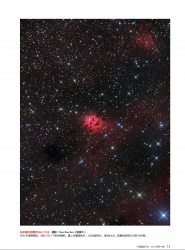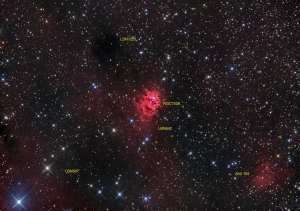NGC7538 Region
 Click image for full size version
Click image for full size version
September 21, 2015; Chinese National Astronomy Magazine, Nov. 2011 issue
 I have turned my attention to an area not far from the famous Bubble Nebula to image the area around NGC7538. I’ve captured the region before, in a wider field that shows both. NGC7538 lies around 9,100 light years away, and is glowing red due to emissions from atoms of hydrogen gas. It is home to the largest known protostar (yet-to-be star), which is more than 300 times the size of our solar system.
I have turned my attention to an area not far from the famous Bubble Nebula to image the area around NGC7538. I’ve captured the region before, in a wider field that shows both. NGC7538 lies around 9,100 light years away, and is glowing red due to emissions from atoms of hydrogen gas. It is home to the largest known protostar (yet-to-be star), which is more than 300 times the size of our solar system.
The field contains many other objects including dark nebulae, patches of red emission nebula and colourful stars, some of which are listed in the annotated image at right.
Tekkies:
SBIG STL-11000M camera, Baader Ha, L, R, G and B filters, 10″ ASA astrograph operating at f/6.8, Paramount MX. Guided with STL-11000’s external guider and 80 mm f/6 Stellar-Vue refractor. Acquisition and guiding with TheSkyX. Focusing with FocusMax. Automation with CCDCommander. Calibration, cosmetic correction, registration, integration and all processing in PixInsight. Shot from my SkyShed in Guelph, Ontario. Nearly full Moon for Ha and no moon for RGB. Good to very good transparency and average seeing throughout acquisition.
12x15m R, G and B, 37x10mL and 14x30m Ha unbinned frames (total=22hr10m).
HaRGB
Creation and cleanup: Ha, L, R, G and B masters were were cropped and processed separately with ABE. The R,G and B channels were combined and processed with ColorCalibration. The NB-RGBCombine Script was applied with default settings to produce a linear HaRGB image. PixelMath was used to boost the blue by adding 5% Ha.
Linear Noise Reduction: MultiscaleLinearTransform was used to reduce noise in the background areas. Layer settings for threshold and strength: Layer 1: 3.0, 0.5 Layer 2: 2.0, 0.39 Layer 3: 1.0, 0.2 Layer 4: 0.5, 0.1
Stretching: HistogramTransformation was applied to make a pleasing yet bright image. TGV Noise was applied and the image was re-stretched to reset the black point.
Synthetic Luminance
Creation and cleanup: The cleaned up Ha, L, R, G and B masters were combined using the ImageIntegration tool (average, additive with scaling, noise evaluation, iterative K-sigma / biweight midvariance, no pixel rejection).
Deconvolution: A copy of the image was stretched to use as a deconvolution mask. A star mask was made from unstretched SynthL to use as a local deringing support. Deconvolution was applied (75 iterations, regularized Richardson-Lucy, external PSF made using DynamicPSF tool with about 20 stars; local deringing at 70% and global dark deringing at 0.04).
Linear Noise Reduction: MultiscaleLinearTransform was applied to reduce the noise. Layer settings for threshold and strength: Layer 1: 3.0, 0.5 Layer 2: 2.0, 0.39 Layer 3: 1.0, 0.2 Layer 4: 0.5, 0.1
Stretching: HistogramTransformation was applied to make a pleasing yet bright image. TGV Noise was applied and the image was re-stretched to reset the black point.
HDR Multiscale Transformation: HDRMT was applied at 6 and 4 pixel scales using a mask to protect stars. LHE was applied at scales of 64 and 120 using the same star mask (strength 0.6 and 0.25, respectively).
Combining SynthL with HaRGB:
The luminance channel of the HaRGB image was extracted, processed and then added back into the HaRGB image as follows:
1. Extract luminance from the HaRGB image.
2. Apply LinearFit using SynthL as the reference.
3. Use ChannelCombination in Lab mode to replace the HaRGB’s luminance with the fitted luminance from step 2.
4. LRGBCombine was then used to make a SynthLHaRGB image.
Final Processing
Star shapes were smoothed and sizes reduced by applying MorphologicalTransformation through the same star mask using the Midpoint operator, with default settings. A light unsharp mask was then applied to the stars. A range mask for the brightest highlights minus stars was made by subtracting a star mask from a range mask. The highlights were sharpened slightly with unsharp mask. Overall contrast and brightness were increased slightly with the Curves tool.
Image scale is about 1.1 arcsec per pixel for this camera / telescope combination.







Leave A Comment